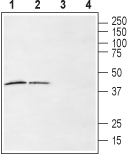Overview
- Peptide STHSQGNNASEAC, corresponding to amino acid residues 156-168 of human LPA receptor 6 (Accession P43657). 2nd extracellular loop.

 Western blot analysis of rat (lanes 1 and 3) and mouse (lanes 2 and 4) brain membranes:1,2. Anti-LPAR6 (P2RY5) (extracellular) Antibody (#ALR-036), (1:200).
Western blot analysis of rat (lanes 1 and 3) and mouse (lanes 2 and 4) brain membranes:1,2. Anti-LPAR6 (P2RY5) (extracellular) Antibody (#ALR-036), (1:200).
3,4. Anti-LPAR6 (P2RY5) (extracellular) Antibody, preincubated with LPAR6/P2RY5 (extracellular) Blocking Peptide (#BLP-LR036).
- Gendaszewska-Darmach, E. et al. (2008) Acta Biochim. Pol. 55, 227.
- Noguchi, K. et al. (2003) J. Biol. Chem. 278, 25600.
- Yanagida, K. et al. (2009) J. Biochem. 284, 17731.
- Oh, D.Y. et al. (2006) Int. Rev. Cytol. 252, 163.
- Pasternack, S.M. et al. (2010) Nat. Genet. 40, 329.
Lysophosphatidic acid (LPA; 1- or 2-acyl-sn-glycerol-3-phosphate) is a bioactive lipid molecule with a phosphate, a glycerol, and a fatty acid in its structure. The cellular effects of LPA include proliferation, migration, cytokine secretion, and morphological change. These pleiotropic actions allow LPA to participate in a wide variety of biological processes, such as brain development, oncogenesis, wound healing and cancer progression1. To date, at least 6 subtypes of LPA receptor have been identified. The LPA1-3 receptors are members of the endothelial cell differentiation gene (Edg) family2.
LPA6 (P2Y5) was cloned as an orphan GPCR and is closely related to the fourth lysophosphatidic acid receptor, LPA43. GPCRs share a similar topology, with seven transmembrane helices (TMHs) connected by three extracellular loops (ECLs), and three intracellular loops (ICLs); the N terminus is on the extracellular side of the membrane, and the C terminus is on the cytoplasmic side4.
LPA6 mRNA is expressed ubiquitously including in skin and hair follicle cells.
A recent study suggested that LPA6 is essential for human hair growth. A loss of function is not compensated for, and ultimately leads to pathological changes and hair loss5.
Application key:
Species reactivity key:
Alomone Labs is pleased to offer a highly specific antibody directed against an epitope of the human LPA receptor 6. Anti-LPAR6 (P2RY5) (extracellular) Antibody (#ALR-036) can be used in western blot analysis and indirect flow cytometry. The antibody recognizes an extracellular epitope and is thus ideal for detecting the receptor in living cells. It has been designed to recognize LPA receptor 6 from mouse, rat and human samples.

